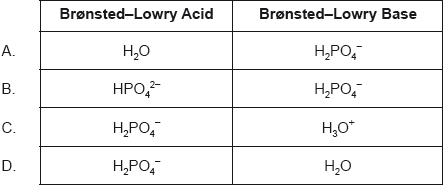| Date | November 2021 | Marks available | 2 | Reference code | 21N.2.sl.TZ0.5 |
| Level | SL | Paper | 2 | Time zone | TZ0 |
| Command term | Formulate | Question number | 5 | Adapted from | N/A |
Question
Phosphoric acid, H3PO4, can undergo stepwise neutralization, forming amphiprotic species.
Formulate an equation for the reaction of one mole of phosphoric acid with one mole of sodium hydroxide.
Formulate two equations to show the amphiprotic nature of H2PO4−.
Calculate the concentration of H3PO4 if 25.00 cm3 is completely neutralised by the addition of 28.40 cm3 of 0.5000 mol dm−3 NaOH.
Outline the reason that sodium hydroxide is considered a Brønsted–Lowry base.
Markscheme
H3PO4 (aq) + NaOH (aq) → NaH2PO4 (aq) + H2O (l) ✔
Accept net ionic equation.
H2PO4− (aq) + H+ (aq) → H3PO4 (aq) ✔
H2PO4− (aq) + OH− (aq) → HPO42− (aq) + H2O (l) ✔
Accept reactions of H2PO4− with any acidic, basic or amphiprotic species, such as H3O+, NH3 or H2O.
Accept H2PO4− (aq) → HPO42− (aq) + H+ (aq) for M2.
«NaOH »
«» 0.004733 «mol» ✔
«» 0.1893 «mol dm−3» ✔
Award [2] for correct final answer.
«OH− is a» proton acceptor ✔


